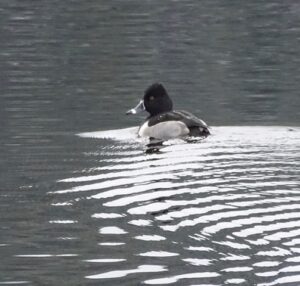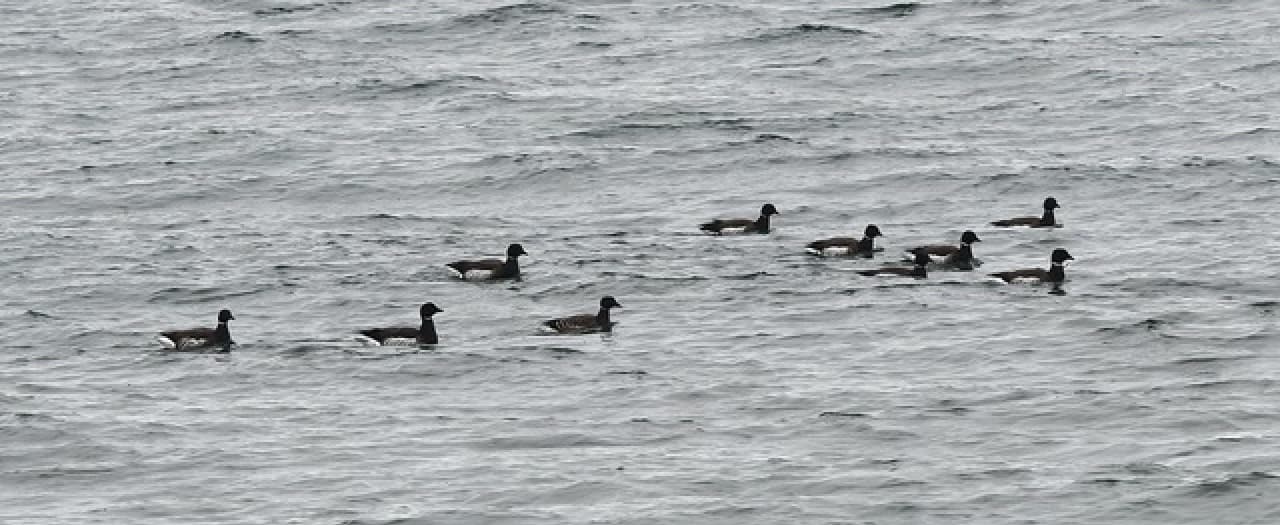Christmas Bird Count 2021/2022 – by George Sirk

Sunday, 5 January 2022, was a wonderfully brisk birding day for the 29 participants of the Cortes Island Museum’s Annual Audubon Christmas Bird Count (CBC). Probably the coldest weather in the twenty years that the Museum has been sponsoring the count. The daytime temperature dipped to minus 4 C, but it was calm and overcast and it made for a great outing.
Some of the participants submitted home bird feeder reports, and due to the pandemic protocols, the observers in the field were usually singly or in groups of two or three. The island was subdivided into areas and the teams stayed within their zones to not double count individual birds.
The Cortes Museum was co-ordinating the groups, their associated territory, and providing bird lists and maps online. It was an extra big job as it all had to be done at arm’s length due to the pandemic. Additionally, the Museum (Gina) collected all the data, usually by emails, and compiled the final tally. I (George) helped to highlight birds that needed extra documentation of the observation, Rare Bird Reports (RBR), either because it was unusual or rare, or the numbers were so high that the data needed more information. Gina and I met at the museum and reviewed all the RBRs submitted. All the RBRs and data were then submitted to the Audubon Society and Birds Canada. It must have been like a Traffic Control Tower at a busy airport at Gina’s computer at the Museum!
So now to the count! We recorded 70 different bird species, a total of 2963 individuals in the 24-hour period and five additional species during the “count week” (CW). When we look at the 20-year history of the count, our average is 70.7 species! (Don’t you love the 0.7 of a bird? I guess, it’s one of those one-legged gulls that we occasionally see!) So, we are bang on the average. Quite neat. Naturally, there are variables like number of observers, weather, extra-long lunch breaks, …, which affect the total, but all in all our 70 is the norm. Total [bird] individuals over the 20 years average comes to 2953, and incredibly this year we were only 10 over that at 2963! For fun, if we now extrapolate out to the number of birds that are actually here, I would guess we have about 80 to 90 species and 5000 individuals residing in the winter here on Cortes. We used to use boats in the previous century to census the waters around Cortes that are in the count area, and if we did that type of census again, we would get a more accurate seabird count. It’s difficult to do that from land.

So, can you guess which species is the most abundant on Cortes? Clue – it’s a seabird. And which is the most abundant land bird? Clue – you hardly ever see them in the summer, and you break the bank feeding them in winter!
Answers: The most abundant species is the seabird, Surf Scoter, this year at 1096 – roughly a third of all the individuals(!) – the 20-year average is 680. The most abundant land bird is the Dark-eyed (Oregon) Junco, this year at 188. The 20-year average is 250.
We also had one bird this year that has never been recorded before, a Spotted Sandpiper, reported and photographed by Chris Napper’s group. This bird has been missing from Cortes for decades and, interestingly enough, Chris found a nest of them last year with three young in Whaletown Bay. It looks like they are on the verge of re-colonizing Cortes. Nice. His group also got a Greater Yellowlegs, a large slim grey sandpiper with – you guessed it! – bright yellow legs. This is the third record for that bird. Another third record is the Snow Goose.
In the count week (CW), Tamias spotted a small flock of the rare Bohemian Waxwing at Smelt Bay – also a new bird for the count and for the Cortes checklist!
[divider]
Other notables include Norah’s Brant Geese, with photos; and “small owls” were reported by Diana Manson. Remember, if you spot a rare or unusual bird, please do your best to photograph it – even a cell phone photo can be useful.

Seven is the average number of Anna’s Hummingbirds – we got thirteen. Their population is truly askew as more of us are feeding them in the winter. Ten years ago, the average was two. Last year we had 31! If you are going to feed them in the winter be prepared to work hard to keep the feeders from freezing: bring them in at night and get them out first thing in the morning. Many of us struggled during the week-long cold snap to keep our feeders free and clear. The hummers have the ability to go into “torpor,” which is like a mini hibernation, during the very cold nights. They sit motionless with their bills in the air. Mine were actually doing that during the day at the peak of the snap! They are now singing and going into nesting season. The first record of Anna’s Hummingbirds for Cortes was in 1983. It has colonized Cortes successfully and it’s now a resident bird.
To summarize, the count is a good indicator of our bird and habitat health. Over 2100 individuals of “seabirds” were documented – two thirds of all the birds. Most of these birds are only here in the winter – Cortes is an important winter staging local. The seabirds feed on the rich waters and associated marine life that is abound here. Those Surf Scoters love the clams! The Murrelets fatten up on all the small fish. They need to store a lot of fat for their spring migration north and the females have the extra energy demand of creating their eggs. The health of our ecosystems is paramount, and we must all do what we can to mitigate pollution and overharvesting. The recent federal decree to severely cut back on the herring fishery is a good example of a positive step to help our wildlife. And we can all help our bird population by providing nesting boxes – even our tree nesting ducks, like Hooded Mergansers, need boxes! And if you are on the water – always give resting and feeding seabirds wide berth, as we would for whales. Spring is coming and soon our summer residents will be filling our soundscape with wonderful songs!
We would like to thank all the Cortes Island’s volunteer bird watchers! Without you, we would not be able to keep our birds’ statistics continuously from year to year for the last 20 years.
Check out our Facebook album with birds photographed this year.
Our website page, contains the most recent results.



